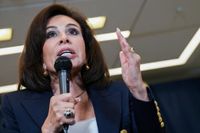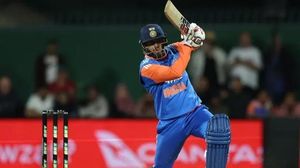Washington, D.C. has become the latest stage for a national debate over crime, immigration, and gun rights, with the Trump administration’s sweeping crackdown and a new, controversial policy on firearms capturing headlines and sparking protests. As federal agents, National Guard troops, and local officials clash over the future of public safety in the nation’s capital, even pop culture has waded into the fray—satirizing the spectacle and stoking further discussion.
It all began on August 7, 2025, when the Trump administration dramatically increased the federal law enforcement presence in D.C. According to Nexstar Media Inc., the initial deployment included 800 unarmed National Guard troops and hundreds of officers from agencies like the FBI, Immigration and Customs Enforcement (ICE), and U.S. Customs and Border Protection. By August 20, the number of law enforcement officers had swelled to nearly 2,000, with six GOP-led states sending their National Guard forces to assist. Plans were quickly announced for these Guard members to begin carrying weapons—a move that unsettled many local leaders.
The White House claimed the crackdown was necessary to combat what President Donald Trump described as “crime, bloodshed, bedlam and squalor, and worse.” Trump declared, “This city will no longer be a sanctuary for illegal alien criminals,” vowing “full, seamless, integrated cooperation at all levels of law enforcement.” Yet, the crackdown’s focus soon came under scrutiny. Of the 556 arrests made since the surge began, nearly half—233—were classified as migrants without legal status, as reported by a White House official on August 20. The list of those arrested ranged from individuals with alleged criminal histories of assault and burglary to delivery drivers detained while picking up food, sparking a backlash from human rights advocates and D.C. residents alike.
Critics, including Mayor Muriel Bowser, have questioned the true intent of the operation. “I think it makes the point that this is not about D.C. crime,” Bowser said, urging the administration to be transparent about its objectives. “Nobody is against focusing on driving down any level of violence. And so if this is really about immigration enforcement, the administration should make that plain.” The geographic placement of troops—most prominent in tourist hot spots and wealthier neighborhoods—has also raised eyebrows, with some seeing it as more about power and optics than genuine public safety.
The crackdown has not gone uncontested. Protests erupted across the city, notably in Columbia Heights, where crowds marched behind ICE agents chanting “ICE go home” until the agents left the area. Viral videos have captured tense encounters, including masked agents using a stun gun on a delivery driver and detaining others in unmarked vehicles. In one case, an agent retorted to a bystander, “liberals already ruined it,” highlighting the charged atmosphere on D.C.’s streets.
Some Democrats see the effort as a political distraction. Delegate Eleanor Holmes Norton posted on X, “Trump is using DC as a stage and DC residents as props in a political play to distract from his Epstein problem. This is unacceptable.” D.C. Council member Charles Allen echoed that sentiment, calling the operation “authoritarianism, power, and control—what this has all been about—made plain.” He added, “It might make sense if he’s trying to create compelling TV and distract folks from the real scandals he’s facing, but it doesn’t make our city safer & it’s a dangerous abuse of power and authority.”
Despite the controversy, some local law enforcement groups have welcomed federal reinforcements. The D.C. Police Union, representing 3,000 officers, reported a 22 percent decrease in violent crimes and an 8 percent drop in all crimes in the first week after the surge. Carjackings, a particular concern in recent years, plummeted by 83 percent. U.S. Attorney General Pam Bondi praised the results, posting, “At the direction of @POTUS, our nation’s capital is a SAFER place—and we are just getting started.” Bondi announced the seizure of 76 guns, including nine on August 18, and promoted a new U.S. Marshals Service campaign offering a $500 reward for information leading to arrests.
Yet, these numbers are not without context. According to the Metropolitan Police Department, violent crime in D.C. had already been declining significantly since its pandemic-era spike, with carjackings falling from 319 in the first eight months of 2024 to 190 over the same span this year. Critics argue that the supposed effectiveness of the federal surge may be overstated, and that the militarization of the city has brought unintended consequences—such as a sharp drop in restaurant reservations and a growing sense of fear among immigrant communities. Rep. Jamie Raskin told MSNBC, “The whole region understands that oppression of people in Washington hurts everybody who lives in our region. We don’t want to see people’s rights being trampled there.”
Amid this tense backdrop, a major policy shift on guns has added another layer to the debate. On August 20, U.S. Attorney Jeanine Pirro announced that her office would no longer pursue felony charges against registered gun owners carrying concealed rifles and shotguns in D.C., aligning with recent Supreme Court rulings that struck down local restrictions in crowded cities. Previously, only registered pistol owners could conceal carry; now, anyone with a permit for a registered rifle or shotgun may do so. Pirro explained to the Washington Post, “Without question, President Donald Trump and I are committed to prosecuting gun crime. This unprecedented number of gun case prosecutions in both federal and local court is only done consistent with the constitution and the laws of the land.”
The policy change comes even as federal and local law enforcement have seized dozens of guns in the city. In 2023, authorities recovered 98 rifles and 38 shotguns, though as the Bureau of Alcohol, Tobacco and Firearms notes, recovery does not imply criminal use. Bondi recently stated that approximately 68 guns have been seized since the federal crackdown began, though she did not specify which types. Pirro emphasized that her office will continue to prosecute unlawful gun possession, especially for those prohibited from owning firearms, but will no longer bring charges for possession of registered rifles or shotguns. This marks a significant departure from previous practices, which saw such laws used in high-profile cases like the 2019 shotgun attack in Northeast Washington and the infamous “Pizzagate” shooter incident.
The national spotlight on D.C. has even found its way into pop culture. On August 20, South Park teased the return of the character Towlie in an episode satirizing the Trump administration’s crackdown. In a 20-second teaser, Towlie appears amid troops and tanks in the capital, wryly commenting on the city’s suitability for a towel. The show’s creators reference data showing a 26 percent decrease in violent crime, poking fun at the administration’s justification for the military presence. Reaction from officials has been mixed: Department of Homeland Security Secretary Kristi Noem criticized the portrayal, while Vice President J.D. Vance embraced the mockery. Despite the White House dismissing the episodes as a “desperate attempt for attention,” the show’s second episode drew 6.2 million viewers across cable and streaming platforms.
As Washington, D.C. grapples with a surge in federal enforcement, shifting gun laws, and the glare of the national spotlight, the city’s future remains uncertain—caught between competing visions of safety, liberty, and the rule of law.




